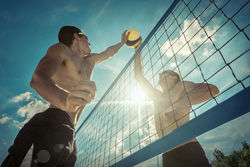Jumper’s knee (patellar tendinopathy)
 The patellar tendon is a strong thick tendon that sits below your kneecap at the front of the knee and is responsible for transferring load between the quadriceps muscle to the shin. These loads are passed through in activities such as stairs, running, jumping and landing. In some cases, loads that are placed through the patellar tendon can be excessive and increased too quickly and the tendon can begin to fail. Inflammatory and degenerate processes then commence and can lead to pain and disrepair.
The patellar tendon is a strong thick tendon that sits below your kneecap at the front of the knee and is responsible for transferring load between the quadriceps muscle to the shin. These loads are passed through in activities such as stairs, running, jumping and landing. In some cases, loads that are placed through the patellar tendon can be excessive and increased too quickly and the tendon can begin to fail. Inflammatory and degenerate processes then commence and can lead to pain and disrepair.
Patellar tendinopathy (aka Jumper’s knee) commonly affects people involved in jumping sports such as basketball and volleyball. it usually presents in scenarios where the load is increased too quickly or excessively. For example, a sudden change in volume/load, or in frequency of training, or potentially after a rest/ off-season period and return to sport too quickly.
Pain is commonly reported just below the kneecap and will often develop over days/ or weeks. It is often worse in the morning or after rest (startup pain) then gets better with activity/warming up with exercise. Then feels worse after cooling down. Rest from the aggravating activity will reduce symptoms in the short term, but there are several factors to address for the long-term solution to this problem.
- Structured strength and conditioning programs help to resolve tendon pain and symptoms.
- Biomechanical analysis is essential to identify biomechanical factors that may contribute to increased loading through the patella tendon. Factors such as weakness in glut muscles, calf muscles, core muscles and quads muscles. Or tightness in thigh muscles, calves and hips may affect the tendon load. Physio will assist in identification of these factors and help address these with specific rehab exercises.
So see your physiotherapist at In Touch Physiotherapy for assessment of your knee and accurate diagnosis, identification of biomechanical factors and rehabilitation of the patellar tendinopathy for prompt recovery and return to sport.
